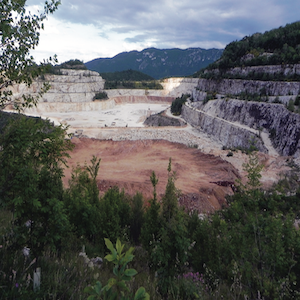Spontaneous renaturalization of open ecosystems in the hills of Brescia seen through the bird community

Accepted: 17 May 2023
All claims expressed in this article are solely those of the authors and do not necessarily represent those of their affiliated organizations, or those of the publisher, the editors and the reviewers. Any product that may be evaluated in this article or claim that may be made by its manufacturer is not guaranteed or endorsed by the publisher.
Authors
The sun-exposed open areas of the Brescia hills overlooking the Po Valley (Avanalpica region) were created by man starting from the 11th century. After the Second World War, following agro-pastoral abandonment, these areas have significantly shrunk. The evolution underway is towards the deciduous forest although in some areas the strong presence of quarries is blocking the vegetational succession or delaying it. Local birds are now largely associated with woodland coenosis and more scarcely with open areas, shrublands and wood edges. Seven open areas species have become extinct over the past 30 years: Woodchat Shrike, Barred Warbler, Rufous-tailed Rock-Thrush, Eastern Black-eared Wheatear, Tawny Pipit, Corn Bunting and Ortolan Bunting. Others, like Red-backed Shrike, Common Whitethroat, Cirl Bunting and Wood Lark have declined. Only the generalist Sardinian Warbler and Blue Rock-Thrush, typical of rocky areas with grassy spaces, are still relatively widespread although slightly decreasing. The Cirl Bunting, a species linked to traditional vineyards and orchards, is not expanding in the new intensively cultivated lands. The Eastern Subalpine Warbler is on the rise even though, due to its very low presence and lack of specific surveys, it may not have been detected in the past. The factors determining the presence of these species, i.e. traditional crops, flat open areas, soils with low grass and often with outcropping and/or rocky substrate, are in sharp decline. We can state that this bird community is negatively influenced by the percentage of tree cover and positively influenced by the presence of quarries which, however, represent an ephemeral and strongly impacting environment. In the absence of fires and/or natural disasters as well as human interventions, which are not likely to occur due to their poor economic sustainability, the prognosis for these birds is to be considered poor and a reduction in both bird and general biodiversity is to be expected.
Downloads
Citations
PlumX Metrics
PlumX Metrics provide insights into the ways people interact with individual pieces of research output (articles, conference proceedings, book chapters, and many more) in the online environment. Collectively known as PlumX Metrics, these metrics are divided into five categories to help make sense of the huge amounts of data involved and to enable analysis by comparing like with like.
How to Cite

This work is licensed under a Creative Commons Attribution-NonCommercial 4.0 International License.
PAGEPress has chosen to apply the Creative Commons Attribution NonCommercial 4.0 International License (CC BY-NC 4.0) to all manuscripts to be published.
Similar Articles
- Gaspare Guerrieri, Amalia Castaldi, The Kestrel, Falco tinnunculus, as an indicator of environmental quality along the coast of Lazio , Rivista Italiana di Ornitologia: Vol. 82 No. 1-2 (2012)
- Fabrizio Florit, Damijana Ota, Roberto Parodi, The monitoring of breeding birds in Friuli-Venezia Giulia , Rivista Italiana di Ornitologia: Vol. 82 No. 1-2 (2012)
- Stefano Giustino, Marcello Bruschini, Elio Esse, Silvana Grimaldi, Danila Mastronardi, Silvia Capasso, Alessio Usai, Maurizio Fraissinet, Wetland selection, niche breadth and overlap in 10 duck species wintering in northern Campania (Italy) , Rivista Italiana di Ornitologia: Vol. 87 No. 2 (2017)
- Giacomo Assandri, Ivan Ellena, Paolo Marotto, Lorenza Piretta, Giovanni Soldato, Mailing lists as ornithological research tool: the example of “Torino Birdwatching” , Rivista Italiana di Ornitologia: Vol. 82 No. 1-2 (2012)
- Salvatore Surdo, Paolo Galasso, Camillo Cusimano, Marco Reale, Manuel Andrea Zafarana, Citizen science project to monitor wildlife: a first census of wintering Booted Eagle Hieraaetus pennatus in Sicily , Rivista Italiana di Ornitologia: Vol. 92 No. 2 (2022)
- Marco Pantalone, Simone Ottorino Bai, Breeding ecology, helpers presence, habitat use and trophic activity of the Greater Short-toed Lark Calandrella brachydactyla: five years of study in Central Adriatic Italy , Rivista Italiana di Ornitologia: Vol. 93 No. 2 (2023)
- Massimo Brunelli, Stefano Sarrocco, Aldo Boano, Ferdinando Corbi, Stefano De Felici, Gaspare Guerrieri, Angelo Meschini, Silvano Roma, Alberto Sorace, Giuliano Tallone, The Atlas of breeding birds of Lazio (PAUNIL 2006-2008) , Rivista Italiana di Ornitologia: Vol. 82 No. 1-2 (2012)
- Roberto G. Valle, Habitat selection and hatching success of the Common Sandpiper Actitis hypoleucos in Italy , Rivista Italiana di Ornitologia: Vol. 94 No. 1 (2024)
- Enrico Caprio, Ivan Ellena, Antonio Rolando, Multi-scalar analysis of bird communities in Monferrato Astigiano woodlands , Rivista Italiana di Ornitologia: Vol. 82 No. 1-2 (2012)
- Walter Guenzani, Fabio Saporetti, Unmanaged forest and bird community: a study in north-western Lombardy , Rivista Italiana di Ornitologia: Vol. 82 No. 1-2 (2012)
<< < 2 3 4 5 6 7 8 9 10 11 > >>
You may also start an advanced similarity search for this article.


 https://doi.org/10.4081/rio.2023.667
https://doi.org/10.4081/rio.2023.667



